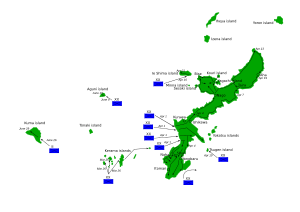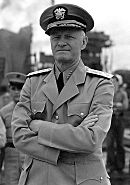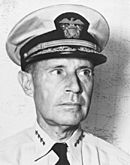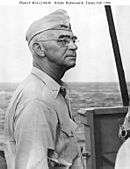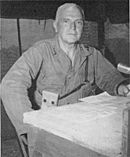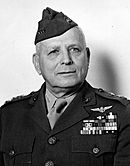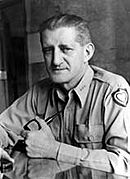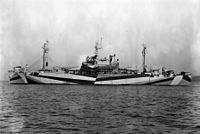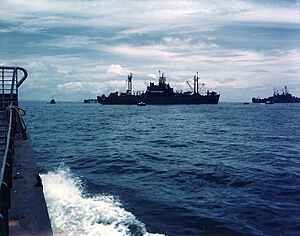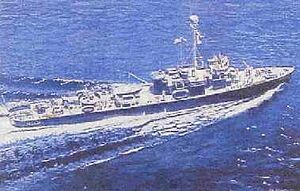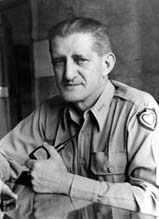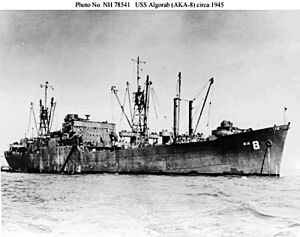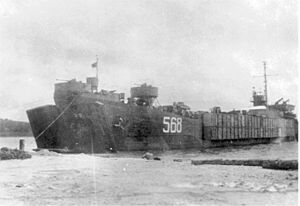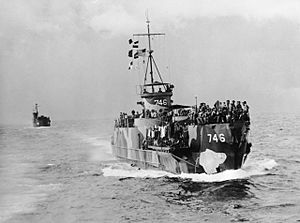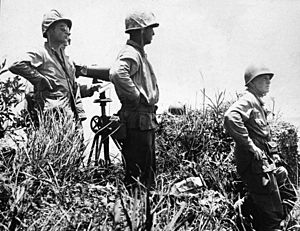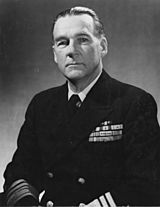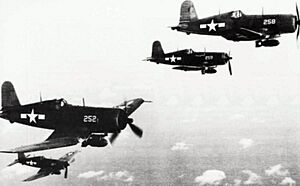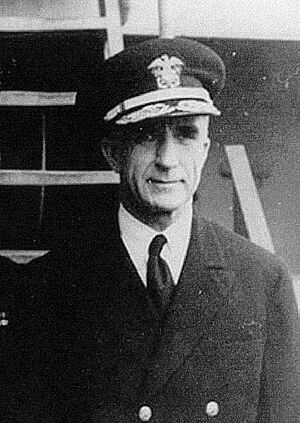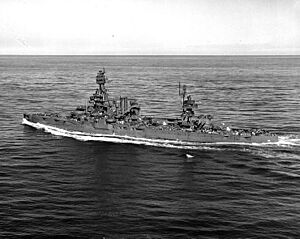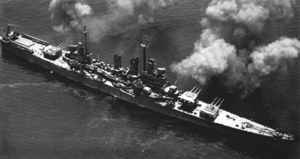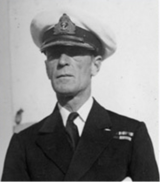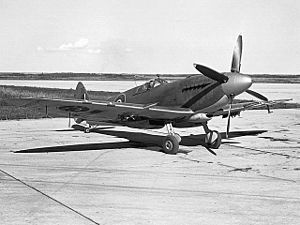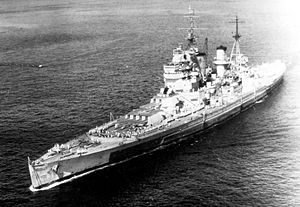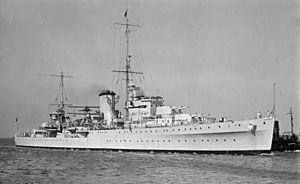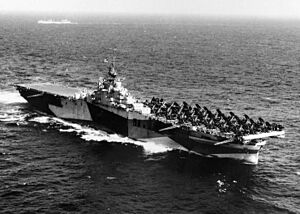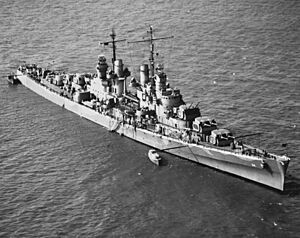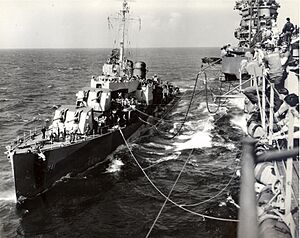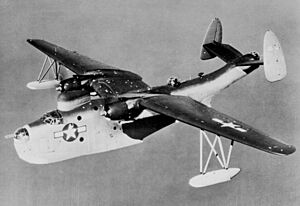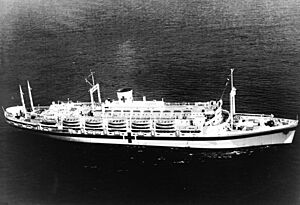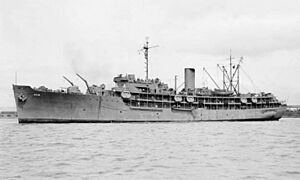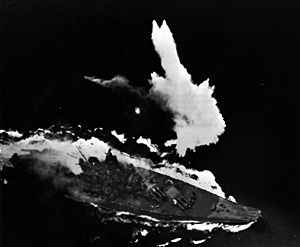Okinawa naval order of battle facts for kids
The invasion of Okinawa was a huge battle in April 1945 during World War II. The Allies, mainly the United States and Great Britain, called this plan "Operation Iceberg." They put together the biggest naval (sea) force ever seen in history!
Japan's main warships had already been sunk or damaged in earlier battles, like the Battle of Leyte Gulf. This meant the Allies didn't face much opposition from large Japanese ships. Only one Japanese battleship, the mighty Yamato, tried to reach the invasion area with a few smaller ships, but it was stopped far away. The main Japanese naval threat came from hundreds of small, fast attack boats.
Japan's air force was also very weak by this point in the war. They didn't have many trained pilots left. Because of this, they used a special and very dangerous tactic called kamikaze. Kamikaze pilots would intentionally crash their planes, loaded with bombs, into Allied ships. This caused a lot of damage and fear.
The Allied forces were truly massive. The United States Navy had:
- 11 large aircraft carriers, 6 smaller ones, and 22 escort carriers (smaller carriers that protect convoys).
- 8 fast battleships and 10 older battleships.
- Many cruisers (large warships) and 132 destroyers (fast, agile warships).
- They also had hundreds of amphibious assault vessels, which are special ships designed to carry troops and equipment directly onto beaches. These included LCIs, LSMs, and LSTs.
- Plus, there were many support ships like submarine chasers, minesweepers, and oilers to refuel other ships.
The Royal Navy (British Navy) also joined the fight with:
- 5 fleet carriers (large aircraft carriers).
- 2 battleships.
- 7 light cruisers and 14 destroyers.
Kamikaze attacks were especially dangerous for smaller ships. Many ships were damaged or sunk by these attacks. For example, 12 ships were sunk by kamikazes, including destroyers like the Twiggs and William D. Porter. Two ships were sunk by mines, and one by a collision.
Contents
Leading the Forces
Admiral Chester W. Nimitz was the top commander for all naval forces in the Pacific Ocean. He led from his headquarters in Pearl Harbor, Hawaii.
The main fleet for this operation was called the Fifth Fleet, led by Admiral Raymond Spruance. His main ship was the USS Indianapolis.
The ships and troops directly involved in Operation Iceberg were commanded by Vice Admiral Richmond Kelly Turner. He was on the amphibious command ship Eldorado.
Ground Troops
The ground forces were led by Lieutenant General Simon Bolivar Buckner, Jr.. Sadly, he was killed during the battle on June 18 when a Japanese artillery shell exploded near him. He was the only U.S. lieutenant general to die from enemy action in World War II. After his death, Major General Roy S. Geiger took command of the Tenth Army.
The main ground forces were:
- United States Tenth Army (led by Lt. Gen. Simon B. Buckner, Jr., then Maj. Gen. Roy S. Geiger).
- III Amphibious Corps (Maj. Gen. Roy S. Geiger)
- This group landed on the left beaches and included the 6th Marine Division and the 1st Marine Division.
- XXIV Army Corps (Maj. Gen. John R. Hodge)
- This group landed on the right beaches and included the 7th Infantry Division and the 96th Infantry Division.
- The 27th Infantry Division joined them later.
- III Amphibious Corps (Maj. Gen. Roy S. Geiger)
Allied Landing Forces
The Allied forces were organized into several large groups, each with a specific job for the invasion.
Joint Expeditionary Force (Task Force 51)
This huge force was led by Vice Admiral Richmond Kelly Turner on the command ship Eldorado. It included many transport ships to carry soldiers and their gear.
- Western Islands Attack Group (Task Group 51.1)
* This group, led by Rear Admiral I.N. Kiland, was responsible for attacking the smaller islands first. * They carried the US 77th Infantry Division and a Marine unit. * They had many attack transports (APA) and attack cargo ships (AKA) to bring troops and supplies. * Special ships like LSTs (which could carry tanks and vehicles directly onto beaches) and LSMs were also part of this group. * They also had support ships like tugboats and repair ships. * A "Screen" of destroyers and destroyer escorts protected these transport ships from enemy attacks.
Northern Attack Force (Task Force 53)
Rear Admiral Lawrence F. Reifsnider led this force on the command ship Panamint. This group carried the III Amphibious Corps, mainly U.S. Marines.
- Transport Group "Able" (Task Group 53.1)
* Carried the 6th Marine Division. They had many attack transports and cargo ships.
- Transport Group "Baker" (Task Group 53.2)
* Carried the 1st Marine Division. They also had many attack transports and cargo ships.
- Northern Tractor Flotilla (Task Group 53.3)
* This group had many LSTs and LSMs to bring heavy equipment and vehicles to the beaches.
- Northern Attack Force Screen (Task Group 53.6)
* Destroyers and destroyer escorts protected this attack force.
- Northern Defense Group (Task Group 53.7)
* This group brought in more support units and important cargo using LSTs.
Southern Attack Force (Task Force 55)
Rear Admiral John L. Hall led this force on the command ship Teton. This group carried the XXIV Army Corps, which were U.S. Army soldiers.
- Transport Group "Dog" (Task Group 55.1)
* Carried the 7th Infantry Division.
- Transport Group "Easy" (Task Group 55.2)
* Carried the 96th Infantry Division.
- Both transport groups had many attack transports, cargo ships, and LSDs (which could carry smaller landing craft).
- They also had "Tractor Groups" with many LSTs and LSMs for beach landings.
- A "Screen" of destroyers and destroyer escorts provided protection.
- The "Southern Defense Group" brought in more supplies and support.
Expeditionary Troops (Task Force 56)
This was the overall group of ground troops, led by Lt. Gen. Simon Bolivar Buckner, Jr.. It included the United States Tenth Army.
- The III Amphibious Corps (Marines) landed in the northern area.
- The XXIV Army Corps (Army) landed in the southern area.
- The US 77th Infantry Division landed later on the western islands.
Allied Combat Ships
These were the warships that provided direct support and fought against enemy forces.
Amphibious Support Forces (Task Force 52)
Rear Admiral William H.P. Blandy led this force. Their job was to support the landings.
- Support Carrier Group (Task Group 52.1)
* Led by Rear Admiral Calvin T. Durgin, this group had many escort carriers. These smaller aircraft carriers launched planes like FM-2 Wildcat fighters and TBM Avenger torpedo bombers to protect the invasion and attack targets on land. * They were divided into three units, each with several escort carriers and a screen of destroyers and destroyer escorts for protection. * A "Special Escort Carrier Group" arrived later with more escort carriers, bringing Marine fighter planes like the F4U Corsair and F6F Hellcat to operate from airfields on Okinawa.
- Mine Flotilla (Task Group 52.2)
* Led by Rear Admiral Alexander Sharp, this group's job was to clear mines from the waters around Okinawa. * They had many fast minesweepers (some were old destroyers converted for this job) and smaller minesweepers. * They also had minelayers (ships that lay mines) and net laying ships to set up defenses.
Gunfire and Covering Force (Task Force 54)
Rear Admiral Morton L. Deyo led this powerful group, mainly from the battleship Tennessee. Their job was to bombard (shell) Japanese positions on Okinawa and protect the invasion fleet.
- This force was made up of several units, each with battleships, heavy cruisers, and light cruisers.
- Battleships like Texas, Maryland, and Nevada used their huge guns to hit targets on the island.
- Cruisers like Tuscaloosa and Wichita also provided heavy firepower.
- Destroyers protected these larger ships.
British Carrier Force (Task Force 57)
Vice Admiral Sir Bernard Rawlings led the British Pacific Fleet. They provided air support and protection.
- First Aircraft Carrier Squadron (Task Group 57.2)
* Led by Rear Admiral Sir Philip L. Vian, this group had 5 large fleet carriers like HMS Indomitable and HMS Victorious. * Their planes included F6F Hellcat and F4U Corsair fighters, and TBF Avenger torpedo bombers.
- First Battle Squadron (Task Group 57.1)
* This group included two powerful battleships, HMS King George V and HMS Howe.
- Fourth Cruiser Squadron (Task Group 57.4)
* This group had 7 light cruisers, including HMNZS Gambia and HMNZS Achilles.
- Destroyer flotillas (groups of destroyers) provided a "Screen" for these larger ships.
- The "British Fleet Train" (Task Force 112) included over 70 support ships like repair ships, oilers, and hospital ships.
Fast Carrier Force (Task Force 58)
This was a very powerful force of aircraft carriers, led by Vice Admiral Marc A. Mitscher on the fleet carrier Bunker Hill. Their planes provided air cover and attacked Japanese targets.
- This force was divided into four Task Groups (58.1, 58.2, 58.3, 58.4), each with:
* Several large fleet carriers (like Hornet, Enterprise, Essex, Yorktown) and light carriers (like Belleau Wood and Cabot). * These carriers launched many different types of aircraft, including F6F Hellcat and F4U Corsair fighters, SB2C Helldiver dive bombers, and TBM Avenger torpedo bombers. * Fast battleships (like South Dakota, Wisconsin, and New Jersey) provided heavy gun support. * Heavy and light cruisers, including large cruisers like Alaska, also provided firepower. * Many destroyers formed a "Screen" to protect the carriers and battleships.
Allied Logistics and Support Vessels
These ships were essential for keeping the massive Allied fleet running. They provided fuel, ammunition, food, and repairs.
Support and Service Units (Task Force 50)
This group, led by Rear Admiral Donald B. Beary, made sure the fighting ships had everything they needed.
- Search and Reconnaissance Group (Task Group 50.5)
* This group used seaplane tenders (ships that support seaplanes) like Hamlin to launch Martin PBM Mariner flying boats. These planes searched for enemy ships and submarines.
- Logistics Support Group Fifth Fleet (Task Group 50.8)
* This was the heart of the support effort. It included: * Support escort carriers to transport planes. * 49 oilers (ships that carry fuel) to refuel other ships at sea. * 16 ammunition ships to resupply guns and bombs. * 9 cargo ships to bring in general supplies. * 8 hospital ships (like Comfort and Mercy) to care for wounded sailors and marines. * Reefer ships (refrigerated store ships) for food. * Repair ships and floating drydocks to fix damaged vessels. * Many tugboats to help move ships. * These support ships were protected by a screen of destroyers and destroyer escorts.
Japanese Forces
The Japanese forces were much smaller than the Allies' at this point in the war.
Surface Special Attack Force
This small but determined force was led by Vice Admiral Seiichi Ito. It was meant to be a one-way mission to disrupt the Allied invasion.
- The main ship was the super battleship Yamato, one of the largest battleships ever built.
- It was accompanied by the light cruiser Yahagi and several destroyers.
- This force was almost completely destroyed by Allied air attacks before it could reach Okinawa.
Ships Damaged or Sunk at Okinawa
The Battle of Okinawa was very costly for both sides, especially due to the intense kamikaze attacks. Many Allied ships were hit. The table below shows the Allied naval vessels that were damaged or sunk between March 19 and July 30, 1945.
Overall, Japanese kamikaze attacks damaged over 200 Allied ships. About 4,900 naval officers and sailors were killed, and around 4,824 were wounded or went missing. Most of the ships sunk were smaller ones, like destroyers.
| Allied Naval vessels damaged and sunk by Japanese forces at Okinawa, primarily kamikazes, 19 March – 30 July 1945 | |||||
| Date | Ship Name | Ship Type | Cause of Damage | Killed | Wounded |
| 19 Mar 45 | USS Franklin | Carrier | Air Attack, two 550 lb. bombs | 724 | 265 |
| 19 Mar 45 | USS Wasp | Carrier | Air Attack, bomb hit | 101 | 269 |
| 20 Mar 45 | USS Halsey Powell | Destroyer | Air Attack, kamikaze | 12 | 29 |
| 26 Mar 45 | *USS Halligan | Destroyer | Mine, exploded forward | 153 | 39 |
| 26 Mar 45 | USS Kimberly | Destroyer | Air Attack, kamikaze | 4 | 57 |
| 26 Mar 45 | USS Nevada | Battleship | Air Attack, kamikaze | 11 | 49 |
| 26 Mar 45 | USS Biloxi | Light Cruiser | Air Attack, kamikaze | 0 | 0 |
| 27 Mar 45 | USS Murray | Destroyer | Air Attack, bomb | 1 | 116 |
| 27 Mar 45 | USS O'Brian | Destroyer | Air Attack, Val kamikaze w/bomb | 50 | 76 |
| 28 Mar 45 | *USS Skylark | Small Minesweeper | Mine, struck mines twice | 5 | 25 |
| 28 Mar 45 | USS LSM(R)-188 | Landing Ship | Air Attack by single kamikaze | 15 | 32 |
| 29 Mar 45 | USS Wyandot | Attack Cargo Ship | Mine, possibly bomb | 0 | 1 |
| 31 Mar 45 | USS Indianapolis | Cruiser | Air Attack, bomb thru fuel tanks | 9 | 20 |
| 1 Apr 45 | USS Adams | Destroyer Minelayer | Air Attack, kamikaze w/bombs to fantail | 0 | 0 |
| 1 Apr 45 | USS Alpine | Attack Transport | Air Attack, bomb and kamikaze | 16 | 27 |
| 1 Apr 45 | USS Hinsdale | Attack Transport | Air Attack, kamikaze w/bombs hit waterline | 16 | 39 |
| 1 Apr 45 | #USS LST-884 | Tank Landing Ship | Air Attack, kamikaze, scuttled May 6 | 24 | 21 |
| 2 Apr 45 | *USS Dickerson | Destroyer | Air Attack, kamikaze Nick crashed bridge, scuttled | 54 | 23 |
| 2 Apr 45 | USS Goodhue | Attack Transport | Air Attack, kamikaze glanced mainmast | 24 | 119 |
| 2 Apr 45 | USS Henrico | Attack Transport | Air Attack, kamikaze w/bombs hit bridge | 49 | 125 |
| 2 Apr 45 | USS Achernar | Attack Cargo Ship | Air Attack, kamikaze w/bomb hit starboard | 5 | 41 |
| 3 Apr 45 | USS Wake Island | Escort Carrier | Air Attack, kamikaze blew below waterline | 0 | 0 |
| 3 Apr 45 | USS Pritchett | Destroyer | Air Attack, 500 lb bomb | 0 | 0 |
| 3 Apr 45 | USS Foreman | Destroyer | Air Attack, bomb passed thru bottom | 0 | 3 |
| 3 Apr 45 | USS LST-599 | Tank Landing Ship | Air Attack, kamikaze thru main deck | 0 | 21 |
| 3 Apr 45 | #USS LCT-876 | Landing Craft Tank | Air Attack | 0 | 2 |
| 4 Apr 45 | *USS LCI(G)-82 | Landing Craft, Infantry | Boat | 8 | 11 |
| 5 Apr 45 | USS Nevada | Battleship | Coastal Battery | 2 | 16 |
| 6 Apr 45 | *USS Bush | Destroyer | Air Attack, 3 kamikaze hits, broke in half | 94 | 32 |
| 6 Apr 45 | *USS Colhoun | Destroyer | Air Attack, 4 kamikaze hits | 35 | 21 |
| 6 Apr 45 | USS Howorth | Destroyer | Air Attack, kamikaze struck superstructure | 9 | 14 |
| 6 Apr 45 | USS Hyman | Destroyer | Air Attack, kamikaze hit torpedo tubes | 10 | 40 |
| 6 Apr 45 | #USS Leutze | Destroyer | Air Attack, kamikaze blew at fantail | 7 | 34 |
| 6 Apr 45 | #USS Morris | Destroyer | Air Attack, Kate kamikaze portside | 0 | 5 |
| 6 Apr 45 | USS Mulaney | Destroyer | Air Attack, kamikaze hit depth charges | 13 | 45 |
| 6 Apr 45 | #USS Newcomb | Destroyer | Air Attack, multiple kamikazes | 40 | 24 |
| 6 Apr 45 | USS Haynsworth | Destroyer | Air Attack, kamikaze | 7 | 25 |
| 6 Apr 45 | #USS Witter | Destroyer Escort | Starboard waterline kamikaze | 0 | 5 |
| 6 Apr 45 | USS Fieberling | Destroyer | Air Attack, kamikaze near miss | 6 | 6 |
| 6 Apr 45 | *USS Emmons | Destroyer Minesweeper | Air Attack, 5 kamikaze hits, scuttled | 64 | 71 |
| 6 Apr 45 | *USS Rodman | Destroyer Minesweeper | Air Attack, 4 kamikaze hits | 16 | 20 |
| 6 Apr 45 | USS Defense | Small Minesweeper | Air Attack, two kamikaze strikes | 0 | 9 |
| 6 Apr 45 | *USS LST-447 | Landing Ship | Air Attack, kamikaze hit, bomb blew | 5 | 17 |
| 6 Apr 45 | *SS Hobbs Victory | Small Cargo | Air Attack, kamikaze struck, ignited ammunition | 15 | 3 |
| 6 Apr 45 | *SS Logan Victory | Small Cargo | Air Attack, kamikaze struck, ignited ammunition | 16 | 11 |
| 7 Apr 45 | USS Hancock | Carrier | Air Attack, cartwheeling kamikaze | 72 | 82 |
| 7 Apr 45 | USS Maryland | Battleship | Air Attack, kamikaze hit starboard | 16 | 37 |
| 7 Apr 45 | USS Bennett | Destroyer | Air Attack, kamikaze hit engine room | 3 | 18 |
| 7 Apr 45 | USS Wesson | Destroyer | Air Attack, kamikaze starboard | 8 | 23 |
| 7 Apr 45 | *USS PGM-18 | Small Gunboat | Mine, powerful explosion | 14 | 14 |
| 7 Apr 45 | *YMS-103 | Small Minesweeper | Mine, struck two mines | 5 | 0 |
| 8 Apr 1945 | USS Gregory | Destroyer | Air Attack, port kamikaze amidships | 0 | 2 |
| 8 Apr 45 | USS YMS-92 | Small Sweeper | Air Attack | 0 | 0 |
| 9 Apr 45 | USS Charles J. Badger | Destroyer | Boat threw depth charge or mine | 0 | 0 |
| 9 Apr 45 | USS Sterett | Destroyer | Air Attack, kamikaze hit starboard | 0 | 9 |
| 9 Apr 45 | USS Hopping | Destroyer Transport | Coastal Battery, damaging hits | 2 | 18 |
| 11 Apr 45 | USS Kidd | Destroyer | Air Attack, kamikaze | 38 | 55 |
| 12 Apr 45 | USS Tennessee | Battleship | Air Attack, kamikaze hit signal bridge | 25 | 104 |
| 12 Apr 45 | *USS Mannert L. Abele | Destroyer | Air Attack, kamikaze | 79 | 35 |
| 12 Apr 45 | USS Purdy | Destroyer | Air Attack, splashed kamikaze bomb skidded in | 13 | 27 |
| 12 Apr 45 | USS Cassin Young | Destroyer | Air Attack, kamikaze hit foremast | 1 | 59 |
| 12 Apr 45 | USS Zellars | Destroyer | Air Attack, kamikaze crashed port, bomb blew | 29 | 37 |
| 12 Apr 45 | USS Rall | Destroyer | Air Attack, kamikaze starboard aft, bomb blew | 21 | 38 |
| 12 Apr 45 | USS Whitehurst | Destroyer Escort | Air Attack, kamikaze w/bomb crashed pilot house | 37 | 37 |
| 12 Apr 45 | USS Lindsey | Destroyer Minelayer | Air Attack, 2 kamikaze Val strikes | 56 | 51 |
| 12 Apr 45 | USS LSM(R)-189 | Landing Ship | Air Attack, kamikaze | 0 | 4 |
| 12 Apr 45 | *USS LCS(L)-33 | Landing Craft | Air Attack, kamikaze Val amidships | 4 | 29 |
| 12 Apr 45 | USS LCS(L)-57 | Landing Craft | Air Attack, 3 kamikaze strikes | 2 | 6 |
| 14 Apr 45 | USS Sigsbee | Destroyer | Air Attack, kamikaze damaged port engine | 4 | 74 |
| 16 Apr 45 | USS Intrepid | Carrier | Air Attack, kamikaze crashed deck | 10 | 87 |
| 16 Apr 45 | USS Bryant | Destroyer | Air Attack, kamikaze to bridge | 34 | 33 |
| 16 Apr 45 | USS Laffey | Destroyer | Air Attack, multiple kamikaze hits | 31 | 72 |
| 16 Apr 45 | *USS Pringle | Destroyer | Air Attack, kamikaze Val hit, broke in half | 65 | 110 |
| 16 Apr 45 | USS Bowers | Destroyer Escort | Air Attack, kamikaze to bridge | 48 | 56 |
| 16 Apr 45 | #USS Harding | Destroyer Minesweeper | Air Attack, kamikaze struck side | 22 | 10 |
| 16 Apr 45 | USS Hobson | Destroyer Minesweeper | Air Attack, near miss kamikaze's bomb | 4 | 8 |
| 16 Apr 45 | USS LCS(L)-116 | Landing Craft | Air Attack, kamikaze hit aft gun mount | 12 | 12 |
| 18 Apr 45 | USS LSM-28 | Landing Ship | Air Attack | 0 | 0 |
| 22 Apr 45 | USS Isherwood | Destroyer | Air Attack, kamikaze w/bomb crashed gun mount | 42 | 41 |
| 22 Apr 45 | *USS Swallow | Small Sweeper | Air attack, bad kamikaze hit, sunk | 2 | 9 |
| 22 Apr 45 | USS LCS(L)-15 | Landing Craft | Air Attack | 15 | 11 |
| 27 Apr 45 | #USS Hutchins | Destroyer | Boat explosive blew close | 0 | 0 |
| 27 Apr 45 | #USS Rathburne | Destroyer | Air Attack, kamikaze hit port bow | 0 | 0 |
| 27 Apr 45 | *SS Canada Victory | Small Cargo | Air Attack, kamikaze hit stern, lit ammo, sunk | 12 | 27 |
| 28 Apr 45 | USS Pinkney | Destroyer | Air Attack, kamikaze hit aft, lit ammo | 35 | 12 |
| 28 Apr 45 | USS Comfort | Hospital Ship | Air Attack, kamikaze thru 3 decks to surgery | 30 | 48 |
| 29 Apr 45 | #USS Haggard | Destroyer | Air Attack, kamikaze went thru hull, blew engine room | 11 | 40 |
| 29 Apr 45 | USS Hazelwood | Destroyer | Air Attack, kamikaze Zero hit port bridge | 46 | 26 |
| 29 Apr 45 | #USS LCS(L)-37 | Landing Craft | Boat | 0 | 4 |
| 30 Apr 45 | USS Terror | Minelayer | Air Attack, kamikaze blew thru main deck | 48 | 123 |
| 3 May 45 | *USS Little | Destroyer | Air attack, 5 kamikaze strikes | 30 | 79 |
| 3 May 45 | #USS Aaron Ward | Destroyer Minelayer | Air Attack; 3 kamikaze hits and bomb frags | 45 | 49 |
| 3 May 45 | USS Macomb | Destroyer Minelayer | Air Attack, kamikaze | 7 | 14 |
| 3 May 45 | *USS LSM(R)-195 | Landing Ship | Air Attack, kamikaze hit rockets, sunk | 8 | 16 |
| 4 May 45 | USS Hopkins | Destroyer Minesweeper | Air Attack, glancing blow by burning kamikaze | 0 | 1 |
| 4 May 45 | #USS Sangamon | Escort Carrier | Air Attack, kamikaze & bomb blew thru flight deck | 46 | 116 |
| 4 May 45 | USS Birmingham | Light Cruiser | Air Attack, kamikaze hit forward | 51 | 81 |
| 4 May 45 | USS Ingraham | Destroyer | Air Attack, kamikaze above port waterline, bomb blew | 14 | 37 |
| 4 May 45 | *USS Luce | Destroyer | Air Attack, 1st kamikaze bomb hit, 2nd kamikaze struck aft | 149 | 94 |
| 4 May 45 | *USS Morrison | Destroyer | Air Attack, 1st kamikaze hit bridge, then 3 more hit | 159 | 102 |
| 4 May 45 | USS Shea | Destroyer | Air Attack Ohka kamikaze thru starboard bridge | 27 | 91 |
| 4 May 45 | USS Carina | Cargo Ship | Boat ramming caused explosion | 0 | 6 |
| 4 May 45 | *USS LSM(R)-190 | Landing Ship | Air Attack, kamikaze set off her rockets | 13 | 18 |
| 4 May 45 | *USS LSM(R)-194 | Landing Ship | Air Attack | 13 | 23 |
| 9 May 45 | #USS England | Destroyer | Air Attack, kamikaze dive bomber | 35 | 27 |
| 9 May 45 | #USS Oberrender | Destroyer Escort | Air Attack, kamikaze hit starboard gun | 8 | 53 |
| 11 May 45 | USS Bunker Hill | Carrier | Air Attack, 3 kamikaze hits with bombs thru flight deck | 396 | 264 |
| 11 May 45 | #USS Hugh W. Hadley | Destroyer | Air Attack, Aft bomb, an Ohka, and 2 more kamikazes struck | 28 | 67 |
| 11 May 45 | #USS Evans | Destroyer | Air Attack, Struck by 4 kamikazes | 30 | 29 |
| 11 May 45 | USS LCS(L)-88 | Landing Craft | Air Attack | 7 | 9 |
| 13 May 45 | USS Enterprise | Fast Carrier | Air Attack, 2 kamikazes, struck port | 13 | 68 |
| 13 May 45 | USS Bache | Destroyer | Air Attack, kamikaze hit, bomb exploded | 41 | 32 |
| 13 May 45 | USS Bright | Destroyer Escort | Air Attack, kamikaze Zero hit fantail | 0 | 2 |
| 17 May 45 | USS Douglas H. Fox | Destroyer | 2 kamikaze strikes | 9 | 35 |
| 18 May 45 | *USS Longshaw | Destroyer | Coastal Battery, 4 hits, ignited magazine | 86 | 97 |
| 18 May 45 | *USS LST-808 | Landing Ship Tank | Air Attack | 11 | 11 |
| 20 May 45 | #USS Chase | Destroyer Escort | Air Attack, Splashed kamikaze skidded in | 0 | 35 |
| 20 May 45 | #USS Thatcher | Destroyer | Air Attack, kamikaze Oscar struck aft of bridge | 14 | 53 |
| 20 May 45 | #USS John C. Butler | Destroyer Escort | Air Attack, kamikaze hit to mast | 0 | 0 |
| 25 May 45 | USS Stormes | Destroyer | Air Attack, crashed aft torpedo mount | 21 | 6 |
| 25 May 45 | USS O'Neill | Destroyer Escort | Air Attack, kamikaze | 0 | 16 |
| 25 May 45 | USS Butler | Destroyer Minesweeper | Air Attack, kamikaze bombs exploded | 0 | 15 |
| 25 May 45 | #USS Spectacle | Small Minesweeper | Air Attack, kamikaze crashed port gun tub | 29 | 6 |
| 25 May 45 | *USS Barry | Destroyer Transport | Air Attack, kamikaze badly crashed, abandoned | 0 | 30 |
| 25 May 45 | *USS Bates | Destroyer | Air Attack, 2 kamikaze hits, sank | 21 | 35 |
| 25 May 45 | USS Roper | Destroyer | Air Attack, kamikaze hit off Hanagushi | 1 | 10 |
| 25 May 45 | *LSM-135 | Landing Ship | Air Attack, kamikaze caused fires, abandoned | 11 | 10 |
| 25 May 45 | SS William B. Allison, aka USS Inca | Cargo Ship, Liberty Ship | Air Attack, Aerial Torpedo | 8 | 2 |
| 27 May 45 | USS Braine | Destroyer | Air Attack, 2 kamikazes | 66 | 78 |
| 27 May 45 | #USS Forrest | Destroyer Minesweeper | Air Attack, kamikaze crashed starboard | 5 | 13 |
| 27 May 45 | USS Rednour | Transport | Air Attack, 2 kamikaze hits | 3 | 13 |
| 27 May 45 | USS Loy | Destroyer Escort | Air Attack, kamikaze near miss | 3 | 15 |
| 27 May 45 | LCS(L)-119 | Landing Craft | Air Attack | 12 | 6 |
| 28 May 45 | *USS Drexler | Destroyer Escort | Air Attack, 2 kamikaze Frances hits, sunk | 158 | 51 |
| 28 May 45 | USS Sandoval | Attack Transport | Air Attack, kamikaze hit portside | 8 | 26 |
| 29 May 45 | USS Shubrick | Destroyer | Air Attack, kamikaze bomb hit starboard | 32 | 28 |
| 3 June 45 | #USS LCI(L)-90 | Landing Craft Infantry | Air Attack, kamikaze | 1 | 7 |
| 6 June 45 | #USS J. William Ditter | Destroyer Minelayer | Air Attack, 2 kamikaze hits | 10 | 27 |
| 6 Jun 45 | USS Harry F. Bauer | Destroyer Minelayer | Air Attack, kamikaze hit superstructure | 0 | 0 |
| 10 Jun 45 | *USS William D. Porter | Destroyer | Air Attack, splashed kamikaze Val's bomb exploded underwater | 0 | 61 |
| 11 Jun 45 | USS LCS(L)-122 | Landing Craft | Air Attack kamikaze hit conning tower | 11 | 29 |
| 16 Jun 45 | *USS Twiggs | Destroyer | Air Attack, splashed kamikaze and bomb blew in hull, sunk | 126 | 34 |
| 21 Jun 45 | USS Halloran | Destroyer Escort | Air Attack, splashed kamikaze's bomb struck | 3 | 24 |
| 21 Jun 45 | USS Curtiss | Seaplane Tender | Air Attack, kamikaze and bomb hit | 41 | 28 |
| 21 Jun 45 | *USS LSM-59 | Landing Ship | Air Attack, kamikaze strike, sank | 2 | 8 |
| 22 Jun 45 | USS LSM-213 | Landing Ship | Air Attack, kamikaze strike at Kimmu Wan | 3 | 10 |
| 22 Jun 45 | USS LST-534 | Landing Ship Tank | Air Attack, kamikaze hit bow doors | 3 | 35 |
| 29 Jul 45 | *USS Callaghan | Destroyer | Air Attack, bi-plane kamikaze hit, sunk | 47 | 73 |
| 30 Jul 45 | USS Cassin Young | Destroyer | Air Attack, kamikaze hit forward | 22 | 45 |
Images for kids
See also
- List of ships damaged by kamikaze attack
- List of Allied vessels struck by Japanese special attack weapons


